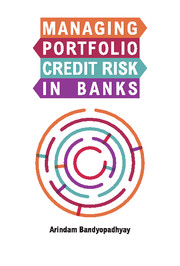Book contents
- Frontmatter
- Dedication
- Contents
- Tables, Figures, Charts
- Preface
- Acknowledgements
- Abbreviations
- 1 Introduction to Credit Risk
- 2 Credit Rating Models
- 3 Approaches for Measuring Probability of Default (PD)
- 4 Exposure at Default (EAD) and Loss Given Default (LGD)
- 5 Validation and Stress Testing of Credit Risk Models
- 6 Portfolio Assessment of Credit Risk: Default Correlation, Asset Correlation and Loss Estimation
- 7 Economic Capital and RAROC
- 8 Basel II IRB Approach of Measuring Credit Risk Regulatory Capital
- Index
4 - Exposure at Default (EAD) and Loss Given Default (LGD)
Published online by Cambridge University Press: 05 May 2016
- Frontmatter
- Dedication
- Contents
- Tables, Figures, Charts
- Preface
- Acknowledgements
- Abbreviations
- 1 Introduction to Credit Risk
- 2 Credit Rating Models
- 3 Approaches for Measuring Probability of Default (PD)
- 4 Exposure at Default (EAD) and Loss Given Default (LGD)
- 5 Validation and Stress Testing of Credit Risk Models
- 6 Portfolio Assessment of Credit Risk: Default Correlation, Asset Correlation and Loss Estimation
- 7 Economic Capital and RAROC
- 8 Basel II IRB Approach of Measuring Credit Risk Regulatory Capital
- Index
Summary
EAD and LGD estimates are key inputs in measurement of the expected and unexpected credit losses and, hence, credit risk capital (regulatory as well as economic). These are the second dimensions of Basel II IRB formula. To estimate LGD and EAD under advanced approach, each bank has to rely on its internal data on defaulted accounts. Basel II specifies that “LGD estimates must be grounded in historical recovery rates” – thus excluding any subjective choice of LGD estimates by banks. Building a drawing power and recovery predictor model from loss perspective side is hard because of non-availability of data within the banks in India. The banks also may not know in which format they should record and collect the relevant data for estimation of these two key risk parameters. This section provides a detailed explanation about EAD and LGD concepts, their estimation methodologies and data collection procedure. It also covers various studies related to EAD and LGD, provides interesting statistics about them, and discusses crucial factors that drive these two risks.
What is Exposure at Default (EAD)?
EAD is the amount of loss that a bank may face due to default. Since default occurs at an unknown future date, this loss is contingent upon the amount to which the bank was exposed to the borrower at the time of default. This is commonly expressed as exposure at default (EAD). In the case of normal term loan, exposure risk can be considered small because of its fixed repayment schedule. This is not true for all other lines of credit (e.g. guarantee, overdraft, letter of credit, etc.). The borrower may draw on these lines of credit within a limit set by the bank as and when borrowing needs arise.
Credit line usage has cyclical characteristics, i.e. the use increases in recessions and declines in expansions. The usage rate increases monotonically as the borrower becomes riskier and approaches towards default risk. Banks as a lender need to closely monitor the potential exposure to assess the credit risk more prudently. It is in this sense that the estimation of EAD is absolutely necessary for computation of regulatory as well as economic capital.
- Type
- Chapter
- Information
- Managing Portfolio Credit Risk in Banks , pp. 137 - 185Publisher: Cambridge University PressPrint publication year: 2016



